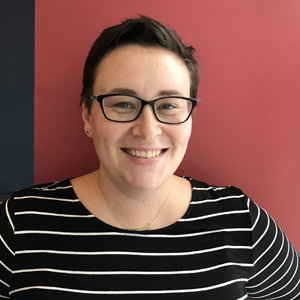Lauren Jost
 What is your primary artistic medium?
What is your primary artistic medium?
I consider my primary medium to be storytelling. I direct (and occasionally perform in) theatre performances for very young children, and I use visual language, puppetry, music, and words to compose stories that spark imaginations and playfulness. A great deal of my teaching artist work involves crafting stories with students, and I consider that an integral part of my artistic practice.
How did you get started as a teaching artist?
I began working as a teaching artist at the Seattle Children’s Theatre after college, because I was interested in exploring non-scripted and devised theatre, and the theatre education world was where I saw that work happening the most. I fell in love with arts integration, devising, and storytelling, and have worked as a teaching artist ever since
What led you to Creative Aging?
I wanted to explore how arts education could benefit community members outside of the K-12 population, and a colleague invited me to co-teach a Creative Aging course. I quickly realized that older adults were so motivated and creative, and eager to participate in the creative process and hungry for storytelling. Creative Aging has been a staple of my teaching work ever since, and it helps to fulfill and sustain my own creativity as a teacher.
What has been the biggest surprise in working with older adult learners?
As a young person, I assumed that my elders were more conservative than I, but ,in fact, my students are usually revolutionaries! They have spent their lives blazing trails and redefining stereotypes, and getting into all sorts of trouble. This makes for incredible storytelling, but also real bonding as the participants see the many diverse ways that their community members have lived their lives and transformed their world. The storytelling class can be a catalyst for not only reflecting on those experiences, but inspiring them to continue reinventing and revolutionizing their world as they continue to age.
What are the differences and similarities in working with the K-12 and older adult populations?
The biggest difference is that older adults want to be in the room learning, and they don’t have to stay if they aren’t getting something out of it. This makes for a much more authentically engaged group of students, but also a certain pressure to make sure their individual needs are being met.
What have been your biggest challenges? How do you respond?
My biggest challenge is always navigating interpersonal dynamics between group members. Sometimes personalities clash, and storytelling is hard when you don’t feel like you have the trust and respect of your group. We work hard to build a safe and respectful dynamic in the class, and to hold participants accountable when someone feels that their work isn’t being respected. Ultimately, this effort is worthwhile, and most group members appreciate the vulnerability and empathy that storytelling can spark.
What is the most satisfying aspect of this work?
Working with older adults is personally satisfying when I can see them developing relationships with each other that will last beyond the class. I often hear “This class has changed everything for me” and I don’t think it is because of me, or even the work necessarily, but from the opportunity to connect and build relationships with new people. Making art and telling stories opens our eyes to the potential in our lives, no matter what point on the age spectrum we may be.
What have been your most memorable moments?
One week we decided to write a group poem about our bodies, and reflect on how we feel about the parts of us that are changing as we age. It started off very reflective, but soon the giggles started and to my shock a room full of quiet older women started plunging into bawdy jokes and hysterical laughter. I learned several things that day, and one of them was not to make assumptions about my students’ modesty!
What skills are most important when working with older adults?
-Patience and listening.
-Not assuming that you know what they are going to say or think.
-Being flexible and willing to abandon your plan for an even better idea.
-Meeting them where they are at and responding to their personal goals.
-Letting yourself be surprised.
How does this work inform your own artistic process?
This work has solidified my own practice as a storyteller, confirming that the power of stories lies in vulnerability and authenticity, not flashy spectacle or heightened circumstances. We all have stories to tell, and the real power comes in the connection between the teller and the listener, and the conversation between the two.
What are your current or upcoming teaching or artistic projects?
I am producing a series of storytelling performances for young children in Brooklyn this year! These stories use visuals, puppetry, language, and music to create imaginative worlds for young ones to explore: http://www.spellboundtheatre.com/
Thank you Lauren for your wonderful work with Lifetime Arts.
To contact Lauren, check out her Teaching Artist Profile on Lifetime Arts’ Roster.
Search the Roster to find qualified Teaching Artists in your area.
Check back each month where we will feature a new Teaching Artist who has excelled in their work with the Creative Aging process.

